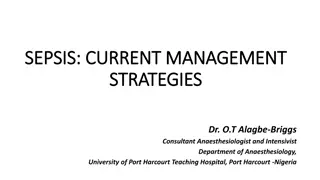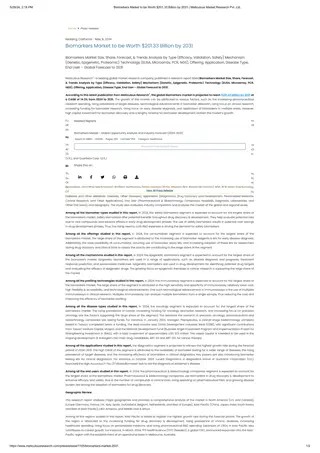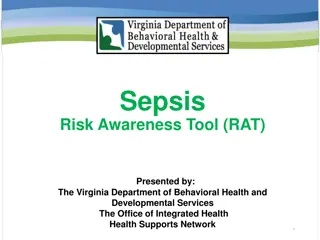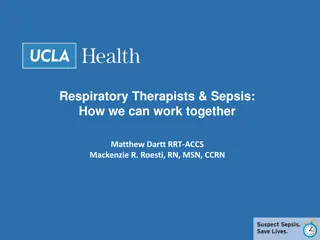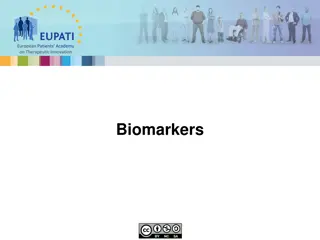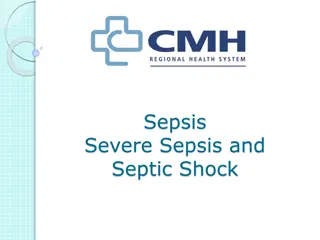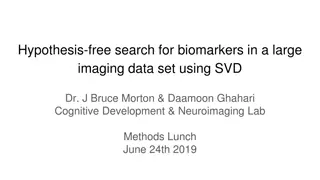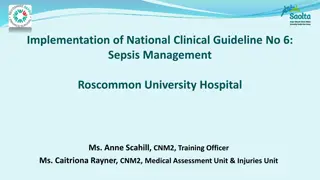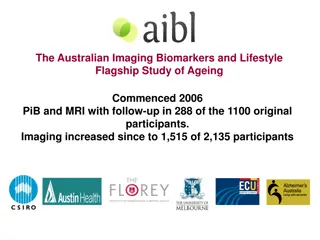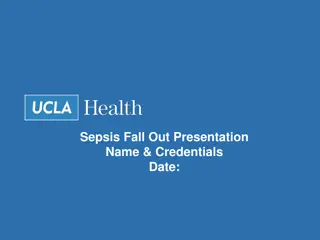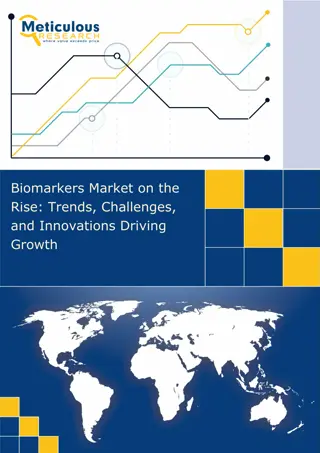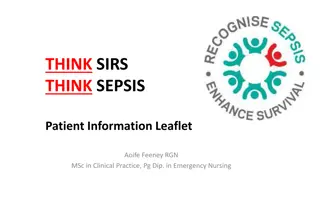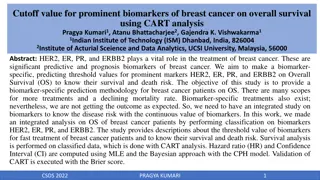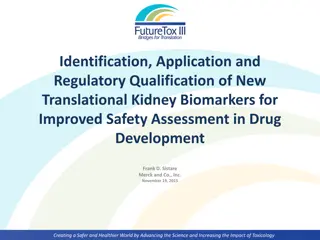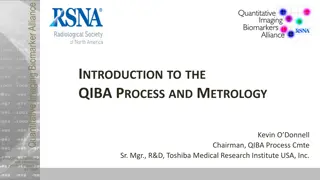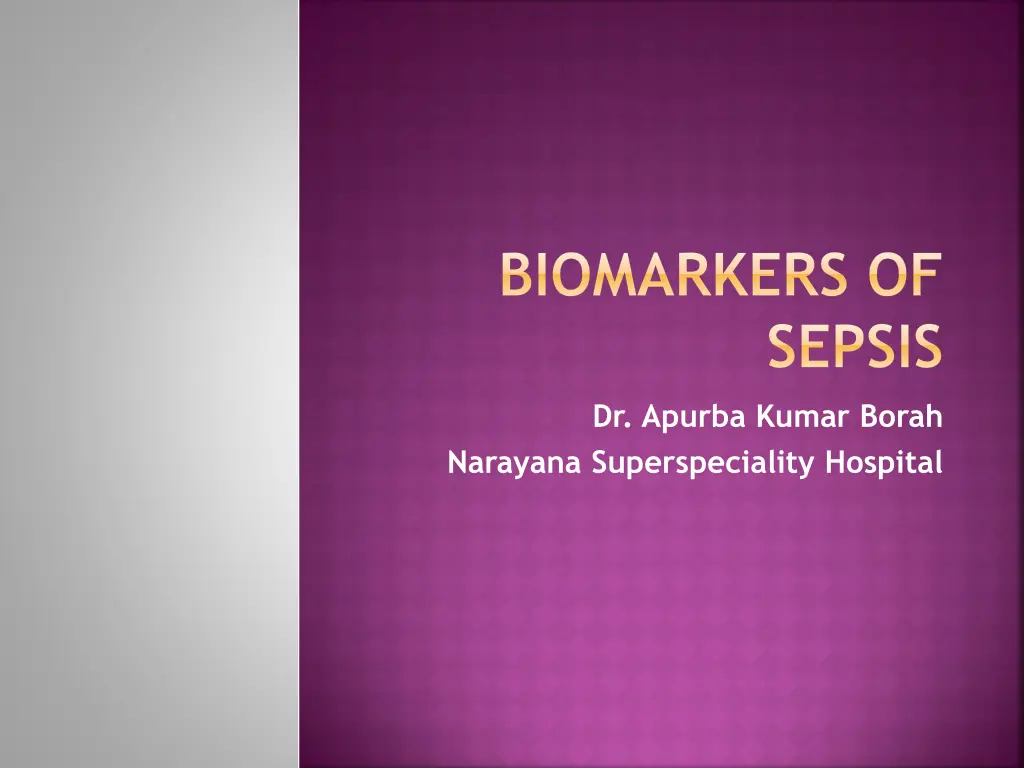
Understanding Sepsis Biomarkers
Explore the history, importance, and uses of biomarkers in sepsis management. Learn about different categories of biomarkers and the ongoing research in this critical area of healthcare.
Download Presentation

Please find below an Image/Link to download the presentation.
The content on the website is provided AS IS for your information and personal use only. It may not be sold, licensed, or shared on other websites without obtaining consent from the author. If you encounter any issues during the download, it is possible that the publisher has removed the file from their server.
You are allowed to download the files provided on this website for personal or commercial use, subject to the condition that they are used lawfully. All files are the property of their respective owners.
The content on the website is provided AS IS for your information and personal use only. It may not be sold, licensed, or shared on other websites without obtaining consent from the author.
E N D
Presentation Transcript
BIOMARKERS OF SEPSIS Dr. Apurba Kumar Borah Narayana Superspeciality Hospital
HISTORY The word sepsis was derived from the ancient Greek for rotten flesh and putrefaction. Sepsis is a state caused by microbial invasion from a local infectious source into the bloodstream which leads to signs of systemic illness in remote organs, this was the first scientific definition of sepsis proposed by Dr. Schottmuller in 1914.
IMPORTANCE Sepsis is a leading cause of death in critically ill patients despite the use of modern antibiotics and resuscitation therapies. The septic response is an extremely complex chain of events involving inflammatory and anti inflammatory processes, humoral and cellular reactions and circulatory abnormalities. However, the early diagnosis and stratification of the severity of sepsis is very important, increasing the possibility of starting timely and specific treatment
USES OF BIOMARKERS Biomarkers can indicate the presence or absence or severity of sepsis [1,2], and can differentiate bacterial from viral and fungal infection, and systemic sepsis from local infection. Other potential uses roles in prognostication, guiding antibiotic therapy, evaluating the response to therapy and recovery from sepsis, differentiating Gram-positive from Gram negative microorganisms as the cause of sepsis, predicting sepsis complications and the development of organ dysfunction (heart, kidneys, liver or multiple organ dysfunction).
BUT??? However, the exact role of biomarkers in the management of septic patients remains undefined [3]. C-reactive protein (CRP) has been used for many years [4,5] but its specificity has been challenged [6]. Procalcitonin (PCT) has been proposed as a more specific [7] and better prognostic [8] marker than CRP, although its value has also been challenged [9].
PIERRAKOS AND VINCENT CRITICAL CARE 2010, 14:R15HTTP://CCFORUM.COM/CONTENT/14/1/ R15 A total of 3370 studies that assessed a biomarker in sepsis were retrieved; 178 different biomarkers were evaluated in the 3370 studies.
LISTS OF CATEGORY OF BIOMARKERS Cytokine/chemokine biomarkers Cell marker biomarkers Receptor biomarkers Coagulation biomarkers Biomarkers related to vascular endothelial damage Biomarkers related to vaosdilation Biomarkers of organ dysfunction Acute phase protein biomarkers Other biomarkers
WHAT WE HAVE?? Of the 178 biomarkers, 18 had been evaluated in experimental studies only, 58 in both experimental and clinical studies, 101 in clinical studies only. Thirty four biomarkers were identified that have been assessed for use specifically in the diagnosis of sepsis.
FINDINGS IL-12 was measured in newborns wnen clinically suspected. Interferon-induced protein 10 (IP-10) was higher in neonates with sepsis and necrotizing enterocolitis. Group II phospholipase 2 (PLA2-II) in adult. CD64 in adults. Neutrophil CD11b pediatric The sensitivity and specificity of the other 11 biomarkers used to diagnose early sepsis were not reported or were less than 90%.
INTERESTING FINDINGS Biomarkers can be more useful to rule out sepsis than to rule it in. We identified three biomarkers with high negative predictive value to rule out sepsis: PCT (99% at a cut-off value of 0.2 ng/ml) [10] Activated partial thromboplastin time (aPTT) waveform (96%) [11] Fibrin degradation products (100% for Gram- negative sepsis by ELISA assay) [12].
WHAT NEXT?? PIRO model has been proposed as a way of stratifying septic patients according to Predisposing condition Severity of Infection Response to therapy Organ dysfunction [13].
INFERENCE: PCT and CRP have been most widely used, but even these have limited abilities to distinguish sepsis from other inflammatory conditions or to predict outcome. In view of the complexity of the sepsis response, it is unlikely that a single ideal biomarker will ever be found. A combination of several sepsis biomarkers may be more effective, but this requires further evaluation.
COMBINATION OF MARKERS A clinical study showed that the combination of aPTT waveform with PCT increased the specificity of the aPTT waveform in the diagnosis of sepsis [14]. Studies using panels of sepsis biomarkers have also provided encouraging results [15-17]. The cost-effectiveness of all these methods must also be evaluated.
REVIEW ARTICLE BioMed Research International Volume 2014 (2014), Article ID 547818, 6 pages http://dx.doi.org/10.1155/2014/547818 Biomarkers for Sepsis Cesar Henriquez-Camacho and Juan Losa
INFERENCE New biomarkers such as those in this review will discuss the major types of biomarkers of bloodstream infections/sepsis. soluble triggering receptor expressed on myeloid cells-1 (sTREM-1) soluble urokinase-type plasminogen receptor (suPAR) proadrenomedullin (ProADM) presepsin.
PRESEPSIN MOST PROMISING Cluster of differentiation 14 (CD14) is a glycoprotein expressed on the membrane surface of monocytes and macrophages and serves as a receptor for lipopolysaccharides (LPSs) and LPS-binding proteins (LPBs). By activating a proinflammatory signaling cascade on contact with infectious agents, CD14 has a role as a recognition molecule in the innate immune response against microorganisms. During inflammation, plasma protease activity generates soluble CD14 (sCD14) fragments. One of them, called sCD14 subtype (sCD14-ST), or presepsin, is normally present in very low concentrations in the serum of healthy individuals and has been shown to be increased in response to bacterial infections [18]. Plasma levels of presepsin can be measured using an automated chemoluminescent assay (PATHFAST).
A SINGLE NUCLEOTIDE POLYMORPHISM (SNP) Because SNPs occur frequently throughout the genome and tend to be relatively stable genetically, they can be used as excellent biological markers in sepsis. Lixin Xie Department of Respiratory Medicine, Hainan Branch of Chinese PLA General Hospital, China Vice Director of Department of Respiratory Medicine, Chinese PLA General Hospital, China
COMBINED BIOMARKERS AND SEPSIS SCORING SYSTEMS Infect Chemother. 2014 Mar; 46(1): 1 12. Published online 2014 Mar 21. doi: 10.3947/ic.2014.46.1.1 PMCID: PMC3970312 Biomarkers of Sepsis Sung-Yeon Cho1,2and Jung-Hyun Choi1,2 Korea
DEVELOPMENT AND VALIDATION OF A NOVEL MOLECULAR BIOMARKER DIAGNOSTIC TEST FOR THE EARLY DETECTION OF SEPSIS Crit Care. 2011; 15(3): R149. A panel of 42-gene expression markers. The area under the curve (AUC) receiver operator characteristics (ROC) curve findings demonstrated sepsis prediction within a mixed inflammatory population, was between 86 and 92%.
BIOMARKERS FOR FUNGAL INFECTIONS Mannan (M) Antimannan (AM) antibodies -D-glucan tests
BIOMARKERS FOR VIRAL INFECTIONS IFN- -inducible protein 10 (IP-10) Aproinflammatory chemokine, is a promising biomarker for diagnosing viral infections due to its role in the host response to viral infections.
REFERENCE 1. Biomarkers Definitions Working Group: Biomarkers and surrogate endpoints: preferred definitions and conceptual framework. Clin Pharmacol Ther 2001, 69:89-95. 2. Marshall JC, Reinhart K: Biomarkers of sepsis. Crit Care Med 2009,37:2290-2298. 3. Dellinger RP, Levy MM, Carlet JM, Bion J, Parker MM, Jaeschke R, Reinhart K,Angus DC, Brun-Buisson C, Beale R, Calandra T, Dhainaut JF, Gerlach H,Harvey M, Marini JJ, Marshall J, Ranieri M, Ramsay G, Sevransky J,Thompson BT, Townsend S, Vender JS, Zimmerman JL, Vincent JL:Surviving Sepsis Campaign: international guidelines for management of severe sepsis and septic shock: 2008. Crit Care Med 2008, 36:296-327. 4. Povoa P, Coelho L, Almeida E, Fernandes A, Mealha R, Moreira P, Sabino H:C-reactive protein as a marker of infection in critically ill patients. ClinMicrobiol Infect 2005, 11:101-108. 5. Schmit X, Vincent JL: The time course of blood C-reactive protein concentrations in relation to the response to initial antimicrobial therapy in patients with sepsis. Infection 2008, 36:213-219.
REFERENCE 6. Clyne B, Olshaker JS: The C-reactive protein. J Emerg Med 1999,17:1019-1025. 7. Nakamura A, Wada H, Ikejiri M, Hatada T, Sakurai H, Matsushima Y,Nishioka J, Maruyama K, Isaji S, Takeda T, Nobori T: Efficacy of procalcitonin in the early diagnosis of bacterial infections in a critical care unit. Shock 2009, 31:591. 8. Luzzani A, Polati E, Dorizzi R, Rungatscher A, Pavan R, Merlini A: Comparison of procalcitonin and C- reactive protein as markers of sepsis. Crit Care Med 2003, 31:1737-1741. 9. Tang BM, Eslick GD, Craig JC, McLean AS: Accuracy of procalcitonin for sepsis diagnosis in critically ill patients: systematic review and metaanalysis. Lancet Infect Dis 2007, 7:210-217.
REFERENCE 10. Liaudat S, Dayer E, Praz G, Bille J, Troillet N: Usefulness of procalcitonin serum level for the diagnosis of bacteremia. Eur J Clin Microbiol Infect Dis 2001, 20:524- 527. 11. Zakariah AN, Cozzi SM, Van Nuffelen M, Clausi CM, Pradier O, Vincent JL: Combination of biphasic transmittance waveform with blood procalcitonin levels for diagnosis of sepsis in acutely ill patients. Crit Care Med 2008, 36:1507-1512. 12. Deitcher SR, Eisenberg PR: Elevated concentrations of cross-linked fibrin degradation products in plasma. An early marker of gram-negative bacteremia. Chest 1993, 103:1107-1112. 13. Levy MM, Fink MP , Marshall JC, Abraham E, Angus D, Cook D, Cohen J, Opal SM, Vincent JL, Ramsay G: 2001 SCCM/ESICM/ACCP/ATS/SIS International Sepsis Definitions Conference. Crit Care Med 2003, 31:1250-1256.
REFERENCE 14. Zakariah AN, Cozzi SM, Van Nuffelen M, Clausi CM, Pradier O, Vincent JL: Combination of biphasic transmittance waveform with blood procalcitonin levels for diagnosis of sepsis in acutely ill patients. Crit Care Med 2008, 36:1507-1512. 15. Bozza FA, Salluh JI, Japiassu AM, Soares M, Assis EF, Gomes RN, Bozza MT, Castro-Faria-Neto HC, Bozza PT: Cytokine profiles as markers of disease severity in sepsis: a multiplex analysis. Crit Care 2007, 11:R49. 16. Kofoed K, Schneider UV, Scheel T, Andersen O, Eugen-Olsen J: Development and validation of a multiplex add-on assay for sepsis biomarkers using xMAP technology. Clin Chem 2006, 52:1284-1293. 17. Shapiro NI, Trzeciak S, Hollander JE, Birkhahn R, Otero R, Osborn TM, Moretti E, Nguyen HB, Gunnerson KJ, Milzman D, Gaieski DF, Goyal M, Cairns CB, Ngo L, Rivers EP: A prospective, multicenter derivation of a biomarker panel to assess risk of organ dysfunction, shock, and death in emergency department patients with suspected sepsis. Crit Care Med2009, 37:96-104. 18. Bernard GR, Vincent JL, Laterre PF, LaRosa SP, Dhainaut JF, Lopez- Rodriguez A, Steingrub JS, Garber GE, Helterbrand JD, Ely EW, Fisher CJ Jr: Efficacy and safety of recombinant human activated protein C for severe sepsis. N Engl J Med 2001, 344:699-709.

